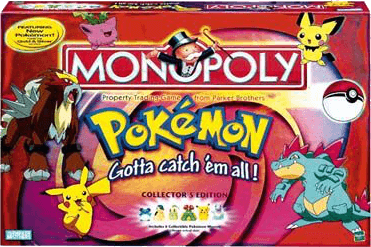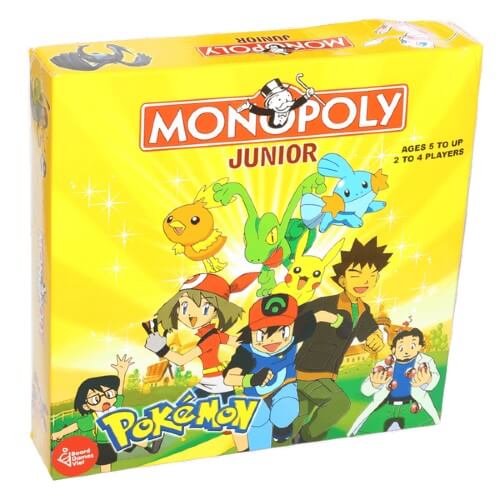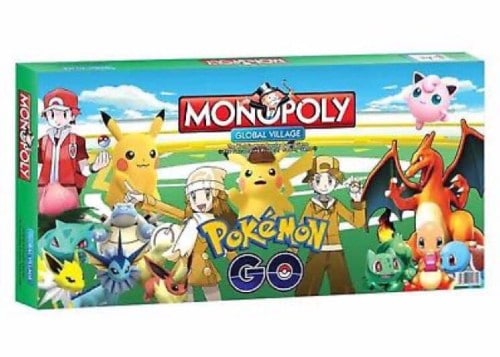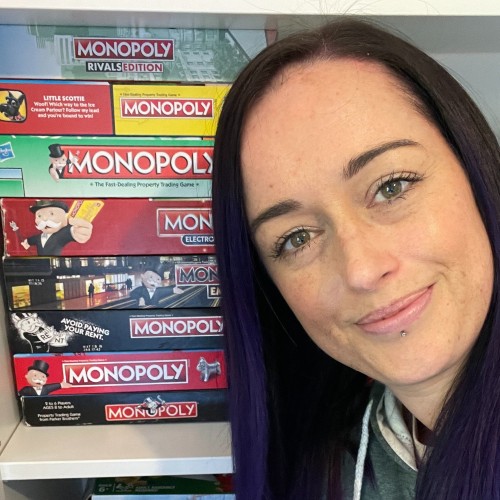In a way, there are a lot of similarities between Pokemon and Monopoly. You want to try to catch ‘em all (the properties, of course) and then level them up to make them stronger (build houses on them…) in order to beat your opponents.
Okay, maybe the links are tenuous at best, but with the incredible popularity of both of these franchises, you won’t be surprised to learn that there have been a number of versions of Pokémon Monopoly made over the years.
So don’t be a Slowpoke, let’s take a look at the options available for a Pokemon Monopoly board game, and see if any of them are the very best, like no one ever was.
Yes, there will be Pokemon puns.
1. Monopoly: Pokemon Edition (1999)

The first Pokemon video games, Pokemon Red and Pokemon Blue, launched in the US in late 1998, and it didn’t take long for Hasbro to capitalize with the release of Pokemon Monopoly a year later.
The graphics used for the game were based on the anime, which helped to propel the world of Pokemon to even further heights with its super-catchy theme song and Pokerap.
Pokemon Monopoly 1999 is broadly played by the same rules as regular Monopoly. The aim of the game is still to collect the most wealth, which you do by acquiring properties, which are replaced in this game by Pokemon.
The Pokemon are themed by gym too, which each color representing a gym from the game, in the same order you would reach them. So the brown spaces are the Rock gym with Geodude and Onix, Light Blue is Water, and so on. Taxes are replaced with rival/Team Rocket attacks, and railroads with PokeBalls.
In the same vein, houses are replaced by Pokemon Centers and hotels by Poke Marts. Chance and Community Chest are also replaced by Professor Oak and Trainer Battle cards. So many references!
There is one main rule difference for this Pokemon Monopoly edition. It’s optional, and it happens when you roll doubles. Now you have the option of either rolling again, or using a Pokemon power:
- Double 1 lets you teleport anywhere on the board, except into Jail, and if you pass Go you collect $200
- Double 2 lets you collect $200 from the bank
- Double 3 lets you collect $50 from each opponent
- Double 4 lets you draw a Professor Oak card
- Double 5 lets you draw a Trainer Battle card
- Double 6 lets you challenge another player for a property they own (providing it’s not part of a completed set). You both roll both dice, and whoever scores highest keeps the property. You re-roll if you tie.
There are actually two versions of this game – one with classic pewter tokens and one with painted pieces that were much brighter and more appealing to younger players.
Both versions are really hard to find and expensive to buy, so if you have one then it’s worth holding onto as it’s considered something of a collector’s item.
Pieces:
- Pewter Tokens Edition: Charmander, Pikachu, Meowth, Psyduck, Poliwhirl, Snorlax
- Plastic Tokens Edition: Bulbasaur, Charmander, Blastoise, Pikachu, Clefairy, Mewtwo
Year: 1999
Players: 2 to 6
2. Monopoly: Pokemon Edition (2001)

In 2001, Hasbro released an updated version of the Collector’s Edition to tie in with the second generation of Pokemon games.
The board was updated to reflect the new gym badges and Pokemon, with the legendary Pokemon Entei becoming the most valuable property in the game, the equivalent of Boardwalk.
Instead of Pokeballs, the railroads took the form of the three Johto starters – Totodile, Cyndaquil, and Chikorita – as well as Heracross, chosen because it was one of the prominent Gen 2 Pokemon in the anime. And Professor Oak cards were replaced with Professor Elm.
Otherwise, the game is extremely similar, with the only other difference being the tokens. They kept the painted colorful style but updated them to include five Pokemon from this new generation, along with Pikachu.
This is another rare game now, having been replaced with the later Johto edition. Expect it to cost upwards of $100 if you want to buy a complete set online.
Pieces: Chikorita, Totodile, Marill, Cyndaquil, Bellossom, Pikachu
Year: 2001
Players: 2 to 6
3. Pokemon Monopoly: Kanto Edition

15 years after it was first launched, the original Pokemon Monopoly game got an update with the Pokemon Kanto Edition game. The rules are exactly the same as in the original in terms of how the game actually works.
The only major differences are in the artwork/naming of some spaces, and the tokens. Firstly the artwork has moved away from the Pokemon anime and instead focuses on imagery closer to the FireRed/LeafGreen games. This means no Ash Ketchum, and the Team Rocket space doesn’t feature Jessie and James but instead two random Rocket grunts. Your rival is also Blue instead of Gary.
The tokens are updated too – these are the metal versions, rather than the colorful painted ones. But if you want to play this more classic version set in the original Kanto region, this version is much easier to find in stores at a more reasonable price point.
Anyone who just wants a Pokemon Monopoly experience without paying for genuine collectables should opt for this version.
Pieces: Bulbasaur, Charmander, Squirtle, Pikachu, Jigglypuff, Eevee
Year: 2014
Players: 2 to 6
4. Pokemon Monopoly: Kanto Exclusive Edition

A year after the previous version, Gamestop released an Exclusive upgraded version of Pokemon Monopoly Kanto edition with two key differences.
Firstly, the number of tokens was expanded to 10, giving players more choice. More importantly, though, Power Cards were also added to the game, giving it another level of strategy.
These are cards that are given to players at the start of the game, and they can only be used once. They’re specific to each token too, so choosing your piece now matters a lot more.
Here’s what they do:
| Pokemon | Power | Effect |
|---|---|---|
| Bulbasaur | Vine Whip | When an opponent buys Pokemon Centers or Poke Marts, you can steal one to place on a property you own (providing you have a color set you can legally add it to). |
| Charmander | Flamethrower | Force a player to return a property to the bank. If they have Pokemon Centers or Poke Marts on it, they must sell them to the bank (at the normal half-value). |
| Squirtle | Hydro Pump | Force a player to sell all Pokemon Centers and Poke Marts at one location back to the bank at normal half-value. |
| Pikachu | Thunderbolt | All opponents move to the Zapdos space (Electric Company) and roll the dice, paying 4x the total to the player. If Zapdos is currently unowned then the player can also buy it. |
| Jigglypuff | Sing | Take an extra turn as all other players ‘fall asleep’. |
| Meowth | Thief | Steal a purchased property (must happen immediately following the purchase of the property). |
| Psyduck | Psychic | When a player plays a Professor Oak or Trainer Battle card, steal it and use the effect for yourself. |
| Cubone | Bonemarang* | When an opponent lands on a property you own, they must pay double the rent due. |
| Magikarp | Flail | When you land on an opponent’s property, instead of paying them rent, they must pay you half the rent. |
| Eevee | Charm | Swap your lowest valued property for the highest valued property owned by an opponent. If they complain you also take an additional $100 from them. Any improvements aren’t traded but are instead sold back to the bank at regular half-value, with the proceeds going to the original owner of the property. |
Quick fact – In the games, the correct spelling is Bonemerang, but it’s misspelled in Monopoly as Bonemarang.
Because this version was only sold by Gamestop and isn’t listed on their store right now, it’s not as easy to find, but it’s worth trying to find it if you want a more tactical game.
Pieces: Bulbasaur, Charmander, Squirtle, Pikachu, Jigglypuff, Meowth, Psyduck, Cubone, Magikarp, Eevee
Year: 2015
Players: 2 to 6
5. Pokemon Monopoly: Johto Edition

There’s not a lot to say about this one – it’s an updated version of Pokemon Monopoly 2001 which the newer artwork style from the Kanto edition used.
The Kanto Edition tends to be more popular since more people grew up loving the first generation of Pokemon but if Pokemon Gold and Silver (or their updates) were more your jam then this is the version to go for.
Pieces: Pikachu, Chikorita, Cyndaquil, Totodile, Pichu, Togepi
Year: 2016
Players: 2 to 6
6. Pokemon Monopoly Junior

Pokemon Monopoly Junior might seem like a great Monopoly game for younger Pokemon fans, but sadly this isn’t an official Monopoly game, it’s a fake copy, and there aren’t many of them around at all.
This game was based on the same structure as other Monopoly Junior games, with a simplified game board that was rectangular rather than square, and lower money values to make it easier to count.
The tokens are cardboard with plastic stands, while the houses and hotels are exactly that – there are no fancy Pokemon Centers or Poke Marts in this knock-off version.
This game does hold the distinction of being the only Monopoly Pokemon game that’s based on a video game that doesn’t just include the first two generations. The box artwork includes Pokemon from the third generation including Treecko and Mudkip, while Pachirisu from the fourth generation of games is one of the playable tokens.
If you happen to come across this Pokemon Monopoly game it might be okay for younger players, but you can’t expect the same quality as you would get from a genuine Pokemon Monopoly set.
Pieces: Ash, Pikachu, Mewtwo, Meowth, May, Pachirisu
Year: Unknown
Players: 2 to 4
7. Pokemon Go Monopoly

Of all the versions of Pokemon Monopoly you could buy, this is the one to avoid. Just like Pokemon Monopoly Junior, it’s not an official version, it’s bootleg. However, this one is still available to buy online.
The game quality is really bad. The tokens are basic cardboard pieces with no novelty design, and the properties are just global cities. The only thing ‘Pokemon’ about it is the center board artwork and the box, otherwise, it’s just a cheap knock-off.
Unless you want a really cheap version of Pokemon Monopoly (and this is cheap, both to buy and in terms of quality), make sure you avoid this one.
Pieces: Colored cardboard tokens
Year: 2020
Players: 2 to 4
The Bottom Line
The easiest version of Pokemon Monopoly to find is the Pokemon Monopoly Kanto Edition, and that’ll probably be the most popular for most players too. It sticks quite closely to the original Monopoly rules, and features Pokemon from the first generation of games which really captured the hearts of most players.
In most games, the Pokemon Monopoly rules are the same as standard Monopoly, but if you can find a copy of the Exclusive Edition you can enjoy a much more strategic game, thanks to the introduction of the Power Cards.
Meanwhile, Pokemon Monopoly Johto is ideal for anyone who thought the second generation of Pokemon games were better than the first.
Just don’t buy the Pokemon Go Monopoly Or Pokemon Monopoly Junior editions. They’re not worth your money.
If you’re a big Nintendo fan, why not check out my review of Monopoly for Nintendo Switch – ideal when you need a break from playing the latest Pokemon game.

